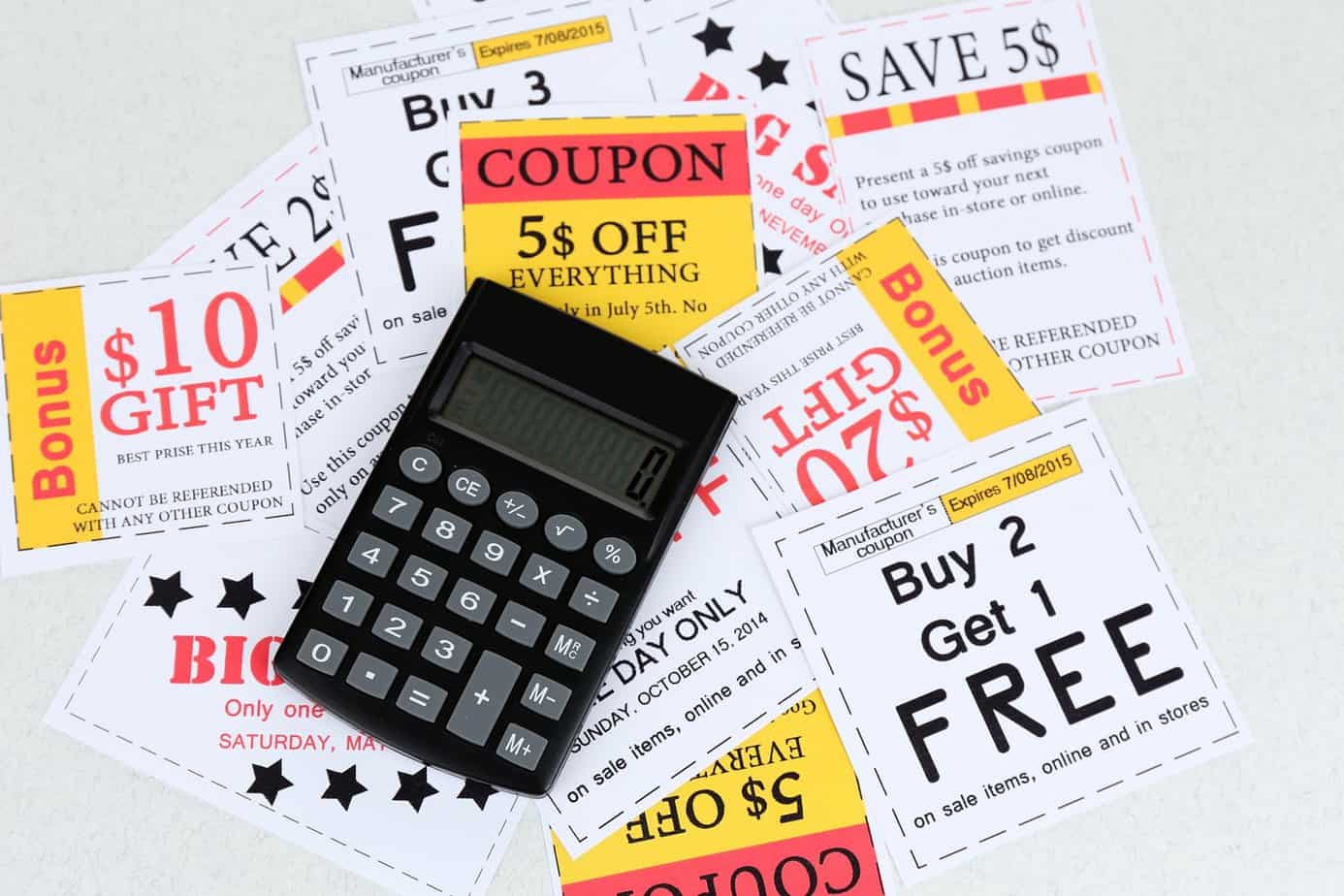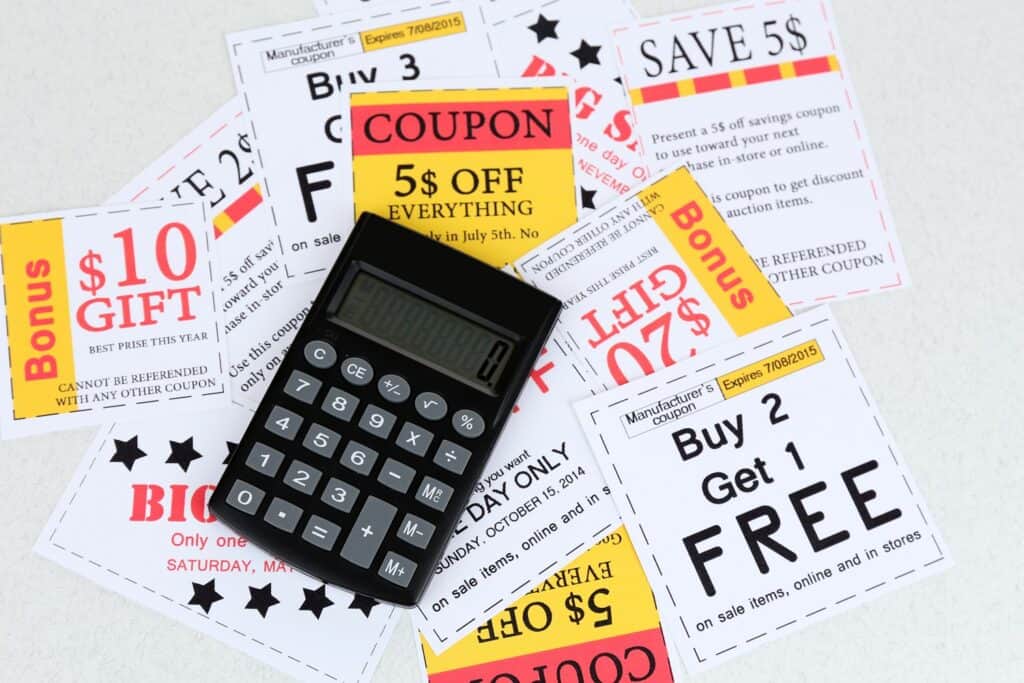What is Coupon Stacking and How to Do It

Savvy shoppers score fantastic deals or even get products for free – and they do it all with coupon stacking. In a nutshell, coupon stacking is a method of using two or more coupons or discounts simultaneously on a single transaction. Think of it as applying multiple layers of savings to your everyday purchases.
Imagine walking out of a store with a cart full of groceries, self-care products, and cleaning supplies that you got for free. Coupon stacking can help you achieve just that. The more discounts you apply to your transaction, the less you will pay.
I started couponing back in high school, armed with nothing more than a handful of coupons clipped from the Sunday paper and a store advertisement. I was thrilled to be able to save a dollar or two on my favorite snacks and beauty products. As time went on, I took breaks from couponing due to college and work, but something kept drawing me back.
When I returned to couponing in 2022 to try to combat inflation, I did so with a determination to master the art of coupon stacking. And master it I did. Using a variety of strategies, I racked up more than $22,000 worth of products for free within just one year.
In this article, I will share my knowledge and experience with you. Whether you’re a high school student trying to save on snacks and beauty products like I once was, a busy parent looking to cut down on the cost of necessities like I am now, or anyone else in between, coupon stacking can be a game-changer.
We foster relationships with brands we use and trust. The testimonials on our site represent real experiences, but they don’t guarantee you’ll achieve similar results. When you make purchases through our links to our partners, we may earn a commission. Your support helps us continue this work. You can read our full disclosure here.
What Is Coupon Stacking?
Coupon stacking involves applying multiple coupons or discounts to a single product or transaction. In short, this ends up being a stack of discounts, hence the name “coupon stacking.” Smart shoppers use variations of this strategy to maximize their savings.
A simple way to stack coupons on a single item is to use one manufacturer coupon and one store coupon. For example, if you have a manufacturer’s coupon for $2 off a jar of peanut butter and a store coupon for $1 off the same product, you can use both coupons at the same time, resulting in significant savings.
I always read through the fine print on my coupons when planning a shopping trip that involves stacking coupons. Some will occasionally state that they cannot be used in combination with other offers. Stores will also occasionally have strict policies regarding coupon stacking, so it’s always a good idea to check the individual retailer’s policy.
In addition to using both a manufacturer’s and store coupon on an item, you can also stack your coupons with store sales or clearance items, brand deals, and cashback offers for even greater savings. The goal of coupon stacking is to get the most value out of every coupon and discount available. This requires a bit of effort and organization, but the potential to get free stuff with coupons make it worth it.
10 Types of Coupons and Discounts You Can (Usually) Stack

While most people stop at using coupons when they’re searching for quick deals, there are far more opportunities to maximize your savings. Here are some of the offerings I check when planning my shopping trips.
1. Manufacturer’s Coupons
Manufacturers issue coupons to encourage potential customers to try their products. For example, a cereal company might offer a $2 off coupon for their new granola. You can find manufacturer coupons in newspapers, magazines, brand newsletters, or even on the product packaging itself.
2. Store Coupons
Coupons issued by a store are only valid at that specific store. For instance, a grocery store might offer a 50 percent off coupon on any dairy product. These can often be found in store flyers, emails, or the store’s website.
Related: Get Paid to Print Coupons
3. Rebates
Rebates are a type of post-purchase discount; you pay the full price upfront, and then receive a partial refund after submitting proof of purchase. For example, a kitchen appliance manufacturer may offer a $20 mail-in rebate on a blender.
4. Cashback Offers
These are typically offered through major credit cards, store credit cards, apps, or websites, and you will receive a percentage of your purchase back as a reward. For instance, a cashback app might offer 5 percent cash back on purchases made at a particular retailer.
Related: Ibotta Review
5. Loyalty Program Discounts
Some stores offer special discounts to their loyal customers as part of a rewards program. For example, a coffee shop might offer a free coffee for every 10 coffees purchased.
6. Special Promotions
These are temporary deals offered by stores, such as “Buy One, Get One Free” (BOGO) or “Spend $50, Save $10.” They’re usually time-sensitive and meant to encourage quick purchases.
7. Clearance or Sale Items
When stores need to clear out inventory, they often significantly discount certain products. For example, holiday-themed items might go on clearance immediately after the event itself.
Related: Rakuten Review
8. Price Matching
While this is a rare occurrence, some stores will match a lower price offered by a competitor. If you have found the same product at a lower price at another retailer, the store you’re visiting might match that price to encourage you to buy it there instead. Some policies may permit matching prices between a store’s online website and its physical stores, while others will match between their own store outlets.
9. Discounted Gift Cards
Websites like Raise sell gift cards that you can purchase for less than their face value. For instance, you might be able to buy a $50 gift card to Target for $40. If this gift card is for a store at which you have coupons, you can use it to make your couponed purchases, effectively saving you money.
Related: How to Get Free Target Gift Cards
10. Store Credit Cards
Many retailers offer their own credit cards that often come with special benefits like exclusive discounts, early access to sales, or cash back on purchases. For example, a store credit card might offer 5 percent cash back on all purchases made at that store. It is important to note that these cards often have high interest rates, so they should be used cautiously and paid off in full each month.
How to Stack Coupons Effectively
It’s time to apply your understanding of deal stacking and put it into practice. When done right, coupon stacking can lead to exceptional discounts, allowing you to save substantially on your purchases. In some instances, you may even get items for free!
Step 1: Research Store Deals and Sales
Start by checking out the weekly ads and specials for your favorite stores. Look for BOGO deals, clearance items, and special promotions. Many stores post their weekly ads online, making it easy and convenient to do this step from home.
Step 2: Collect Coupons
Next, gather your coupons. Check out newspapers, magazines, store flyers, and online coupon sites. Don’t forget to use manufacturer’s coupons, which can be found on product packaging or the manufacturer’s website, as well as store coupons that can be found in storefronts or on store websites.
Step 3: Check Cashback Apps and Websites
Browse through various platforms that offer cashback opportunities on purchases. Apps like Cash App typically have partnerships with numerous manufacturers, and provide a percentage of cash back on purchases made. Some of my favorite cashback apps and websites include Ibotta, Fetch Rewards, and Swagbucks.
Some of these cashback platforms require you to submit your receipts after purchase. After you’ve completed your shopping, you will scan and upload your receipt to the app, and your account will be credited with the corresponding cash back on any eligible items you’ve purchased.
Other platforms like Dosh might offer an automatic cashback feature. In this case, when you use your preferred payment method at checkout, the platform will automatically track your purchases and credit your account with any applicable cash back.
Step 4: Match Coupons, Discounts, and Cash Back Deals
This is where the real savings happen. Pair your coupons and cashback offers with the store deals you already found. For example, if a store has a BOGO deal on cereal, a cashback app offers a $2 refund, and you have a manufacturer coupon for the same cereal, you can stack these discounts for maximum savings. Continue scanning your resources to accumulate even more savings by considering discount gift cards, cashback credit cards, and more.
Step 5: Plan Your Shopping Trip
Make a list of what you plan to buy, and organize your coupons accordingly. Write down all of the items you intend to purchase, and cross-reference this list with the coupons you have, noting down which coupons apply to which items. If you’re using digital coupons or cashback apps, mark these down, as well. This process will help you stay focused and avoid impulse purchases that can blow your budget.
Related: How to Get Paid to Shop
Step 6: Understand Store Policies
Before heading to a store, familiarize yourself with its coupon policy. Some retailers limit the number of coupons you can use per visit, while others may not allow coupon stacking at all. I personally prefer to coupon at only one or two stores. This practice allows me to become well-acquainted with their specific rules and limitations, optimizing my coupon use and ensuring maximum savings.
Step 7: Shop and Stack
As you fill your cart, double-check that you’re choosing the correct items for your coupons. At checkout, present both your store and manufacturer’s coupons for each item. While I shop, I’m able to ensure a smooth and quick transaction by having all my coupons neatly organized and matched to the items in my cart. This not only simplifies the checkout process, but also ensures that each coupon is correctly applied, maximizing my savings and saving me time.
Step 8: Submit Rebates and Check Receipts
After checking out, submit any rebates or cashback offers that were not applied automatically. This process might require uploading your receipt to a website or app, so keep all of your receipts until you’ve secured your rebates and cash back. Check your receipts for store cash that you may be able to apply toward future shopping trips, and note the expiration dates.
Step 9: Review and Track Your Savings
Finally, take a moment to review your receipts and calculate your total savings. This will give you a sense of accomplishment and motivate you to continue coupon stacking.
I recently began the habit of examining my receipts to calculate how much money I’ve saved. Seeing the numbers in black and white has demonstrated significant savings I’m making for my family through couponing. This tangible evidence assures me that the time I put into couponing is indeed worth it, and encourages me to keep going.
Related: P&G Good Everyday Rewards Review: Is It Worth It?
Dos and Don’ts of Coupon Stacking
Coupon stacking is an effective way to save money, but it’s important to do it ethically. Always read coupons’ fine print, and fully understand a store’s coupon policy. Use coupons as intended, and respect their expiration dates.
Avoid practices like photocopying coupons, which are designed for one-time use only. Be considerate of other shoppers and don’t clear the shelves, even if you have a high-value coupon.
Don’t misuse price-matching or ignore coupons’ size, quantity, or brand restrictions. By adhering to these practices, you can maximize savings while maintaining your integrity.
Related: Ibotta vs Rakuten: Can You Use Both Cash Back Apps?
Do Brands and Stores Still Make Money off of Coupon Stackers?
Despite offering substantial discounts through coupons, stores and manufacturers still turn a profit. These strategies ultimately drive higher sales volumes. For example, a $1 off store coupon on a $5 item still leaves the store with $4. When a manufacturer’s coupon is used in combination, the store is reimbursed for the coupon’s value.
Manufacturers issue coupons to foster brand loyalty and clear inventory, hoping customers will become regular buyers. Coupons also attract new customers who might have otherwise shopped at competitors’ locations. When coupons are stacked, the load of discounts is naturally shared between the store and the manufacturer. The strategy benefits savvy shoppers (through savings) and stores and manufacturers (by boosting sales volume and attracting new customers).
When done correctly and ethically, coupon stacking is an exceptional tool that can help you save money on your everyday purchases. It’s not just about getting a deal; it’s about being a savvy shopper who knows how to navigate the world of discounts and promotions. For me, deal stacking is a fun challenge that rewards my family with real, tangible benefits.






